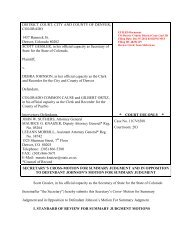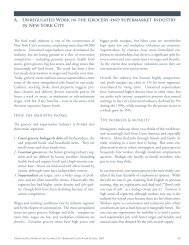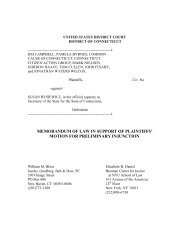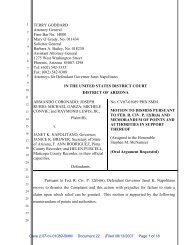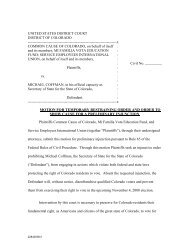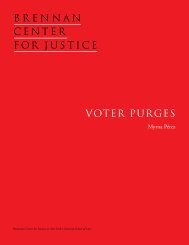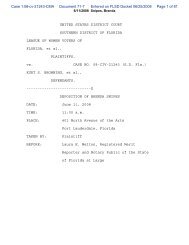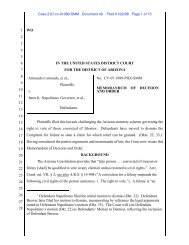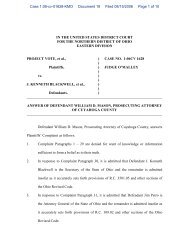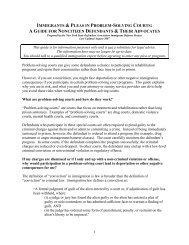Download the Letter [PDF] - Brennan Center for Justice
Download the Letter [PDF] - Brennan Center for Justice
Download the Letter [PDF] - Brennan Center for Justice
- No tags were found...
You also want an ePaper? Increase the reach of your titles
YUMPU automatically turns print PDFs into web optimized ePapers that Google loves.
May 30, 2013Via email and electronic filing through http://www.regulations.govSylvia Ma<strong>the</strong>ws Burwell, DirectorVictoria Collin, Policy AnalystOffice of Management and Budget725 17 th Street, N.W.Washington, D.C. 20503Attention: Office of Federal Financial Management “Grant Re<strong>for</strong>m” – OMB-2013-0001Dear Director Burwell and Ms. Collin:The <strong>Brennan</strong> <strong>Center</strong> <strong>for</strong> <strong>Justice</strong> at New York University School of Law writes to support <strong>the</strong>proposed guidance entitled “Re<strong>for</strong>m of Federal Policies Relating to Grants and CooperativeAgreements: Cost Principles and Administrative Requirements (Including Single Audit Act)”(“Grant Audit Guidance”) issued by <strong>the</strong> Office of Management and Budget (“OMB”) onFebruary 1, 2013 in fur<strong>the</strong>rance of Executive Order 13,520 on “Reducing Improper Payments.” 1The <strong>Brennan</strong> <strong>Center</strong> is a non-partisan public policy and law institute that focuses on improving<strong>the</strong> systems of democracy and justice. 2 The <strong>Brennan</strong> <strong>Center</strong>’s <strong>Justice</strong> Program seeks to ensure arational, efficient, effective, and fair criminal justice system. As part of that mission, we seek toensure that any government funds, particularly federal government grants, earmarked <strong>for</strong>criminal justice purposes are efficiently and effectively used to improve public safety while alsoprotecting individual rights. We have a special interest in grants administered through <strong>the</strong> U.S.Department of <strong>Justice</strong>, specifically <strong>the</strong> Edward Byrne Memorial <strong>Justice</strong> Assistance Grant(“Byrne JAG”) program, which provides grants to state and local governments <strong>for</strong> variouscriminal justice needs. 3 We appreciate <strong>the</strong> opportunity to provide comments on this proposedguidance.1 Re<strong>for</strong>m of Federal Policies Relating to Grants and Cooperative Agreements: Cost Principles and AdministrativeRequirements (Including Single Audit Act), 78 Fed. Reg. 7,282 (proposed Feb. 1, 2013); available athttp://www.gpo.gov/fdsys/pkg/FR-2013-02-01/pdf/2013-02113.pdf ; Exec. Order No. 13,520, 74 Fed.Reg. 62,201(2009); available at http://www.gpo.gov/fdsys/pkg/FR-2009-11-25/pdf/E9-28493.pdf.2 This letter does not represent <strong>the</strong> opinions of NYU School of Law.3 The Byrne JAG Program provides states, tribes, and local governments with critical funding necessary to support arange of program areas including law en<strong>for</strong>cement, prosecution and courts, crime prevention and education,corrections and community corrections, drug treatment and en<strong>for</strong>cement, planning, evaluation, technology
We support OMB’s goal of implementing a streamlined guidance <strong>for</strong> federal grant administrationto increase efficiency and effectiveness. The Grant Re<strong>for</strong>m Guidance would increaseaccountability of grant recipients and improve <strong>the</strong> transparency of federal dollars, <strong>the</strong>rebyensuring <strong>the</strong> most efficient use of public funds and maximizing taxpayer dollars. We support <strong>the</strong>proposed audit language in Subchapter G, which provides clear and mandatory instructions <strong>for</strong>federal agencies and grant recipients concerning <strong>the</strong> audit process. These provisions imposerigorous audit requirements in order to reduce waste, fraud, and abuse in federal grant programs.We have a specific interest in <strong>the</strong> Grant Audit Guidance’s provisions pertaining to per<strong>for</strong>mancemeasurements in <strong>the</strong> grant award process throughout Subchapter B, particularly in <strong>the</strong> sectionsentitled “Agency Review of Merit of Proposals and Risk Posed by Applicants” and “SpecificConditions <strong>for</strong> Individual Recipients.” Those sections confer unnecessarily vast discretion toagencies, and we recommend that <strong>the</strong>y mandate more accountability and transparency. Forexample, section 205 provides that a federal agency reviewing an application need not consideran applicant’s history of failing to meet per<strong>for</strong>mance expectations when assessing risk. Section207 provides that a federal agency may consider an applicant’s failure to meet expectedper<strong>for</strong>mance goals when determining whe<strong>the</strong>r to impose specific conditions on <strong>the</strong> award, but <strong>the</strong>agency retains great discretion in imposing any conditions. Taken toge<strong>the</strong>r, sections 205 and 207allow federal agencies to effectively eliminate past per<strong>for</strong>mance measurements as aconsideration in award determinations. OMB should mandate that agencies incorporate pastper<strong>for</strong>mance into award decisions unless <strong>the</strong>re are exigent circumstances. A history of failure tomeet per<strong>for</strong>mance goals and expectations may indicate a potential of waste, fraud, or abuse inawards to <strong>the</strong> same applicant, and may indicate funds are not being used <strong>for</strong> stated or intendedgoals. For example, a history of failure to meet per<strong>for</strong>mance goals and expectations maydemonstrate that <strong>the</strong> grantee does not understand what <strong>the</strong> award purpose is or how best to utilizefunds to achieve that goal. Without federal agencies addressing this potential issue throughaward decisions, an applicant may perpetually receive federal funds without ever achieving <strong>the</strong>intended statutory goals <strong>for</strong> awards.Additionally, <strong>the</strong> Grant Audit Guidance merely encourages federal agencies to condition awardson specific per<strong>for</strong>mance expectations, ra<strong>the</strong>r than requiring that recipients meet <strong>the</strong>m. Forexample, section 404 provides that federal agencies must include clear per<strong>for</strong>mance goals,indicators, and milestones in federal award notices. However it allows federal agencies to defineper<strong>for</strong>mance goals, which may range from merely submitting technical per<strong>for</strong>mance reports tomeeting specific per<strong>for</strong>mance goals. By allowing agencies to determine when specificper<strong>for</strong>mance goals appropriately apply to an award, <strong>the</strong> Grant Audit Guidance gives federalagencies an opportunity to side-step per<strong>for</strong>mance measures altoge<strong>the</strong>r, allowing recipients todirect grant funds in various ways, which may or may not meet intended statutory goals <strong>for</strong>awards.Per<strong>for</strong>mance measurements help to evaluate <strong>the</strong> effectiveness of federal award programs byproviding data on how often grantees meet award purposes. Measuring <strong>the</strong> effectiveness of aprogram ultimately increases accountability and allows <strong>for</strong> a more nuanced understanding ofimprovement, and crime victim and witness initiatives. See Bureau of <strong>Justice</strong> Assistance, <strong>Justice</strong> Assistance Grant(JAG) Program, available at https://www.bja.gov/ProgramDetails.aspx?Program_ID=59.2
whe<strong>the</strong>r <strong>the</strong> funding to any specific grantee was well spent. Deepened understandings ineffectiveness allow federal agencies to make more appropriate award decisions in <strong>the</strong> future.Fur<strong>the</strong>r, effective per<strong>for</strong>mance measures allow policymakers to make in<strong>for</strong>med decisionsregarding <strong>the</strong> effectiveness of certain programs, as a whole. The Grant Audit Guidance shouldrequire that agencies determine specific per<strong>for</strong>mance goals <strong>for</strong> all awards, unless a particularaward meets a provided exception (i.e., discretionary awards). According to <strong>the</strong> U.S.Government Accountability Office, per<strong>for</strong>mance measures should be “linked to agency goals andmissions; be clearly stated; include measureable targets; and be objective, reliable, andbalanced.” 4 Requiring specific per<strong>for</strong>mance goals as conditions to all federal awards helps ensurefunds are directed to stated and approved purposes, <strong>the</strong>reby increasing efficiency andeffectiveness of federal grants and ensuring that <strong>the</strong> public receives <strong>the</strong> most value from its taxdollars.The Grant Audit Guidance also encourages per<strong>for</strong>mance report best practices, ra<strong>the</strong>r thanrequiring specific report in<strong>for</strong>mation and methodology that support expected per<strong>for</strong>mance goals.For example, sections 502 and 505 encourage <strong>the</strong> collection of detailed per<strong>for</strong>mance in<strong>for</strong>mationin per<strong>for</strong>mance reports to promote program effectiveness and to aid agencies and pass-throughrecipients in managing recipient per<strong>for</strong>mance expectation progress. OMB should instead requiredetailed in<strong>for</strong>mation collections, ra<strong>the</strong>r than merely encourage <strong>the</strong>m. Simply encouraging bestpractices allows federal agencies and award recipients to avoid seeking or providing details inper<strong>for</strong>mance reports. Details on recipient per<strong>for</strong>mance cut waste, fraud, and abuse of federalfunding.The Grant Audit Guidance provides specific and mandatory requirements <strong>for</strong> audit procedures.OMB should undertake a separate guidance implementing <strong>the</strong> same rigor, accountability, andtransparency in per<strong>for</strong>mance measurements <strong>for</strong> federal grants. Such a proposed guidance shouldstreamline and mandate specific per<strong>for</strong>mance goals and reporting requirements to ensureaccountability and transparency in all aspects of grant spending.This new guidance should require federal agencies to uni<strong>for</strong>mly:Consider an applicant’s history of meeting per<strong>for</strong>mance expectations when assessingapplicant risk be<strong>for</strong>e making grant award decisions and when determining whe<strong>the</strong>r toimpose specific conditions on an award;Condition awards on specific per<strong>for</strong>mance goals when making award decisions andevaluating use of grant dollars;Issue specific per<strong>for</strong>mance metrics <strong>for</strong> each federal grant that recipients must meet todemonstrate <strong>the</strong> funds were used to accomplish grant goals, conduct annual evaluationsof recipients’ per<strong>for</strong>mance based on <strong>the</strong>se metrics, and condition grants on whe<strong>the</strong>rrecipients meet such per<strong>for</strong>mance measurements;Collect detailed in<strong>for</strong>mation in per<strong>for</strong>mance reports on where and how federal grantdollars are being spent that measure grant goals and missions;4 U.S. Gov’t Accountability Office, GAO 12-1016, Grants to State and Local Governments: An Overview of FederalFunding Levels and Selected Challenges (2012), available at http://www.gao.gov/assets/650/648792.pdf.3
Publish per<strong>for</strong>mance reports on a publicly accessible and searchable website, likefederalreporting.gov, recovery.gov, or usaspending.gov;Make <strong>the</strong>se per<strong>for</strong>mance measurements consistent with and work in conjunction with <strong>the</strong>cost principles and uni<strong>for</strong>m requirements of <strong>the</strong> Grant Audit Guidance;Consider whe<strong>the</strong>r <strong>the</strong>se per<strong>for</strong>mance measurements should work in tandem with <strong>the</strong>existing assessments on cost factors under <strong>the</strong> Government Per<strong>for</strong>mance and ResultsModernization Act.We recognize <strong>the</strong> difficulty involved in creating a streamlined uni<strong>for</strong>m guidance <strong>for</strong> all federalgrants to improve program efficiency and effectiveness. However, we urge OMB to expand itsef<strong>for</strong>ts to increase <strong>the</strong> rigor of per<strong>for</strong>mance measurements <strong>for</strong> all federal grants, <strong>the</strong>reby requiringincreased accountability, transparency, effectiveness, and efficiency in all aspects of federalgrant spending.Respectfully submitted,Inimai ChettiarDirector, <strong>Justice</strong> ProgramNicole FortierLegal Intern, <strong>Justice</strong> Program<strong>Brennan</strong> <strong>Center</strong> <strong>for</strong> <strong>Justice</strong>at NYU School of Law161 Avenue of <strong>the</strong> Americas, 12th FloorNew York, New York 10013(646) 292-8315inimai.chettiar@nyu.edu4


![Download the Letter [PDF] - Brennan Center for Justice](https://img.yumpu.com/50139248/1/500x640/download-the-letter-pdf-brennan-center-for-justice.jpg)
